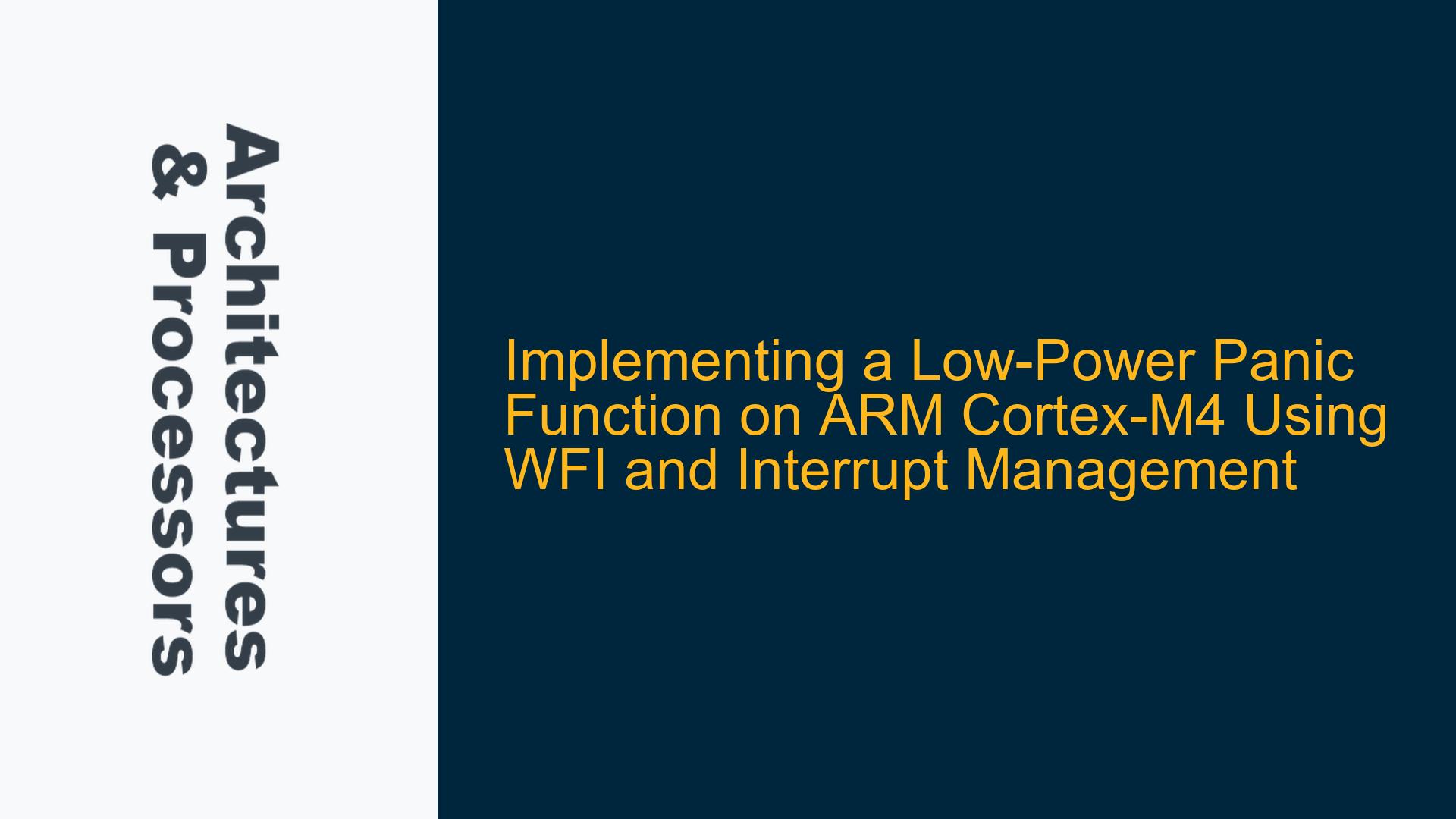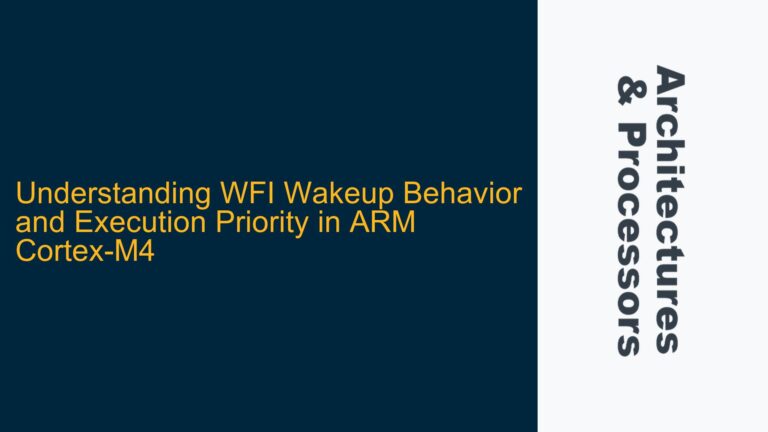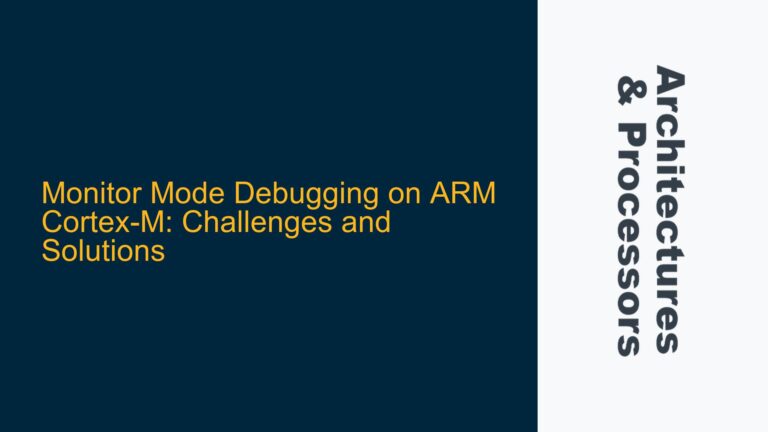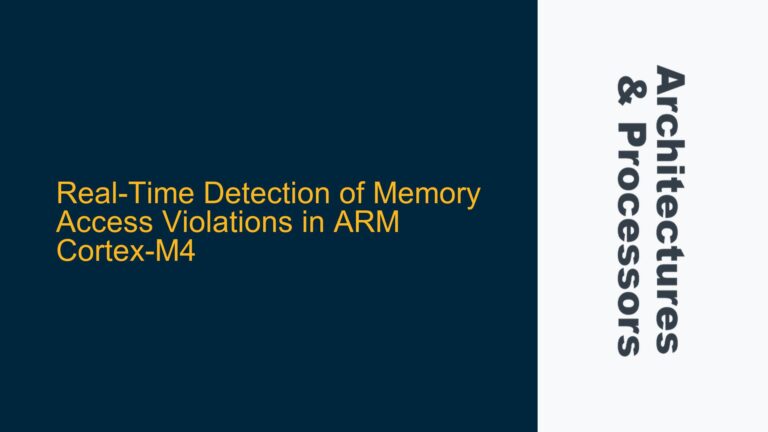ARM Cortex-M4 WFI Behavior and Interrupt Handling in Panic Scenarios
The ARM Cortex-M4 processor provides a Wait For Interrupt (WFI) instruction that allows the processor to enter a low-power state until an interrupt occurs. This feature is particularly useful in embedded systems where power consumption is a critical concern. However, implementing a panic function that leverages WFI to halt the processor in a low-power state presents several challenges, particularly when dealing with interrupt handling and prioritization.
When a panic function is invoked, the goal is to halt the processor in a controlled manner, ideally in a low-power state, until a Non-Maskable Interrupt (NMI) or a hard reset occurs. A naive implementation might involve disabling interrupts and entering an infinite loop with WFI. However, this approach can lead to unexpected behavior due to the way WFI interacts with pending interrupts.
The WFI instruction is designed to wake the processor when any interrupt occurs, regardless of the interrupt’s priority or whether it is masked by the PRIMASK or FAULTMASK registers. This means that if an interrupt is pending when WFI is executed, the processor will immediately wake up, even if the interrupt is not serviced. This behavior can result in the processor oscillating between the WFI state and the awake state, effectively creating a busy loop that consumes as much power as a traditional infinite loop.
To achieve a true low-power halt state, it is necessary to ensure that no interrupts are pending when WFI is executed. This requires a comprehensive approach to interrupt management, including disabling all external and internal interrupts, clearing any pending interrupts, and ensuring that no interrupt sources remain active.
Interrupt Masking, NVIC Configuration, and SysTick Timer Considerations
The primary cause of the WFI wake-up issue in a panic function is the presence of pending interrupts. Even if interrupts are disabled using the CPSID instruction, the WFI instruction will still wake the processor if any interrupt is pending. This behavior is by design, as WFI is intended to wake the processor for any interrupt, regardless of its priority or masking status.
To prevent WFI from waking the processor, it is necessary to disable all interrupt sources and clear any pending interrupts. This involves several steps:
-
Disabling External Interrupts: External interrupts are typically managed by the Nested Vectored Interrupt Controller (NVIC). To disable all external interrupts, the NVIC’s Interrupt Clear Enable Registers (ICER) can be written with a value of 0xFFFFFFFF. This will disable all external interrupts, preventing them from being asserted.
-
Disabling Internal Interrupts: In addition to external interrupts, the Cortex-M4 has several internal interrupt sources, such as the SysTick timer. These interrupts must also be disabled to prevent them from waking the processor. For example, the SysTick timer can be disabled by clearing the SysTick Control and Status Register (CSR).
-
Clearing Pending Interrupts: Even after disabling interrupts, any pending interrupts must be cleared to ensure that they do not cause WFI to wake the processor. The NVIC’s Interrupt Clear Pending Registers (ICPR) can be used to clear any pending interrupts.
-
Setting FAULTMASK: In addition to disabling interrupts using PRIMASK, the FAULTMASK register can be set to disable all interrupts, including fault handlers. This provides an additional layer of protection against unexpected wake-ups.
However, even with these precautions, there are some edge cases to consider. For example, level-triggered interrupts may reassert themselves immediately after being cleared if the underlying hardware signal remains active. In such cases, it may be necessary to disable the interrupt source at the hardware level, which may not be feasible in all scenarios.
Comprehensive Panic Function Implementation with WFI and Interrupt Management
To implement a panic function that reliably halts the processor in a low-power state using WFI, the following steps should be taken:
-
Disable All Interrupts: Start by disabling all interrupts using the CPSID instruction. This sets the PRIMASK register, preventing any interrupts from being serviced.
-
Disable External Interrupts in NVIC: Write 0xFFFFFFFF to the NVIC’s ICER registers to disable all external interrupts. This ensures that no external interrupts can be asserted.
-
Disable Internal Interrupts: Disable internal interrupt sources such as the SysTick timer by clearing the appropriate control registers. For example, disable the SysTick timer by writing 0 to the SysTick CSR.
-
Clear Pending Interrupts: Write 0xFFFFFFFF to the NVIC’s ICPR registers to clear any pending interrupts. This ensures that no pending interrupts can wake the processor from WFI.
-
Set FAULTMASK: For additional protection, set the FAULTMASK register using the CPSID F instruction. This disables all interrupts, including fault handlers, ensuring that no exceptions can wake the processor.
-
Enter WFI Loop: Finally, enter an infinite loop that continuously executes the WFI instruction. With all interrupts disabled and pending interrupts cleared, the processor should remain in a low-power state until an NMI or hard reset occurs.
Here is an example implementation in C using CMSIS-CORE APIs:
void panic(void) {
// Disable all interrupts
__disable_irq();
// Disable all external interrupts in NVIC
for (int i = 0; i < NVIC_NUM_INTERRUPTS; i++) {
NVIC_DisableIRQ(i);
}
// Disable SysTick timer
SysTick->CTRL = 0;
// Clear all pending interrupts
for (int i = 0; i < NVIC_NUM_INTERRUPTS; i++) {
NVIC_ClearPendingIRQ(i);
}
// Set FAULTMASK to disable all interrupts, including fault handlers
__disable_fault_irq();
// Enter low-power state with WFI
while (1) {
__WFI();
}
}
This implementation ensures that the processor enters a low-power state and remains there until an NMI or hard reset occurs. By disabling all interrupt sources and clearing any pending interrupts, the WFI instruction will not wake the processor, allowing it to remain in a low-power state.
Additional Considerations
-
Level-Triggered Interrupts: If level-triggered interrupts are used, it may be necessary to disable the interrupt source at the hardware level to prevent the interrupt from reasserting itself immediately after being cleared. This may involve modifying hardware registers or disabling peripheral clocks.
-
Debugging: When debugging a system that uses this panic function, it is important to ensure that the debugger can still access the processor. Some debuggers may use interrupts to communicate with the processor, so care must be taken to ensure that the panic function does not interfere with debugging.
-
Power Consumption: While the WFI instruction reduces power consumption, the actual power savings will depend on the specific hardware and the power modes supported by the processor. Some processors may support deeper sleep modes that can be entered using additional instructions or hardware configurations.
By following these steps and considerations, a robust and low-power panic function can be implemented on the ARM Cortex-M4 processor, ensuring that the system can halt in a controlled manner while minimizing power consumption.






